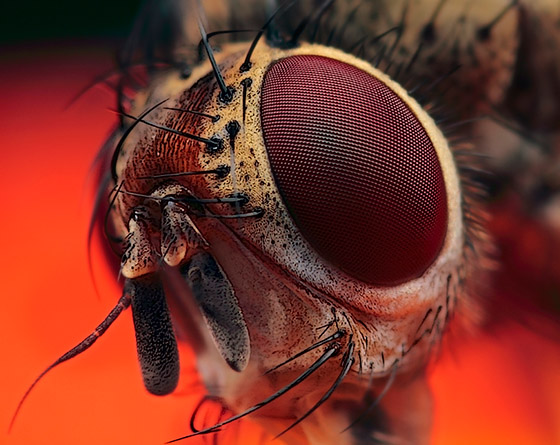
This is a guest post by Huub de Waard, an exceptional photographer who specializes in close-up shots of insects. After reading his post, be sure to check out more of his awesome photos at his website. And, if you’re also interested in writing a guest post here on PhotoNaturalist, please contact me, thanks! –Steve
One of the most popular books that I read during my childhood was Eric in the Land of the Insects, written by the Dutch author Godfried Bomans. In this humorous fantasy, nine-year-old Eric enters the landscape painting that hangs on his wall and he discovers a world of man-sized wasps, bees, butterflies and other insects that is stunningly similar to the world of humans. Once photography became a part of my life and I purchased the Canon extreme macro lens MP-E 65 mm f/2.8, which has combined with a 2x teleconverter a maximum magnification of 10:1, my world was populated with grasshoppers, spiders, snails, flies, dragonflies and butterflies—Eric’s world.
Magnification describes the relationship between the actual size of the subject and the size of its image on the sensor of the camera. Photographing a 3 cm (1.18 inch) long blue-tailed damselfly so that its image size is 1 cm (0.39 inch) on the sensor means that the magnification is 1/3 (1:3) life-size. Dividing the size of the subject’s image on the sensor by the actual size determines the magnification. At 1:1 life-size, the size of the subject on the sensor is as big as it is in real life. Macrophotography is restricted to magnifications in the order of 1:10 to 1:1 life-size. Microphotography is the extreme form of macrophotography, dedicated to the photography of small objects from life-size to modest enlargements of up to about 20. [Read more…] about Introduction to Insect Macro Photography (Part I)
 For the past several years my main bird photography equipment has been one of Canon’s xxD bodies (30D, 40D, 50D and the recent 7D) along with either the Canon 400mm f/5.6L or the Canon 300mm f/4L IS. Sometimes I’ve also used these lenses with the Canon 1.4x Extender.
For the past several years my main bird photography equipment has been one of Canon’s xxD bodies (30D, 40D, 50D and the recent 7D) along with either the Canon 400mm f/5.6L or the Canon 300mm f/4L IS. Sometimes I’ve also used these lenses with the Canon 1.4x Extender.  In a
In a